Fazed by Mahagathbandhan, BJP mulls breaking UP into four
With an eye on the ensuing LS poll, a rattled BJP is now planning to play the regional card to divide Uttar Pradesh, as part of its diversionary politics to continue ruling the country

During a close-door meeting with the Governor of a Bharatiya Janata Party (BJP) ruled state, party president Amit Shah—whose idea of Indian Democracy is Congress Mukt Bharat—admitted that the saffron party will get trounced in Uttar Pradesh, if Congress, Samajwadi Party (SP) and Bahujan Samaj Party (BSP) materialised mahagathbandhan (Grand Alliance) in the ensuing Lok Sabha polls.
Shah—who otherwise is regarded as modern Chanakya in the party—appeared a little worried during the meeting, revealed a highly placed BJP source.
“The party will find it difficult to even cross the double digit mark. Precisely, it will get between three to eight seats,” Shah reportedly acknowledged before the Governor, who is credited for expanding BJP’s base in Western UP before taking up his statutory assignment.
“So, what is the way forward?” asked the Governor.
A few weeks later, answer came from a Union Minister who is considered a prominent, emerging Jat leader within the saffron camp. Talking to a selected group of people in the last week of July at his office in Central Delhi, the Minister is learnt to have told attendees that his party and the Central government are exploring many options to counter the might of the mahagathabandhan. One of the most suitable option to the BJP is division of Uttar Pradesh into four states, the Minister remarked, emphasising that it was the most effective way to checkmate mahagathbandhan in the ensuing general elections.
“He further admitted that growing resentment on the ground will have adverse impact on party’s electoral fortune in Lok Sabha election-2019,” as per a senior journalist who attended the meeting said.
The minister also confirmed that the RSS – BJP’s parental organisation—is also backing BJP’s idea of dividing Uttar Pradesh.
The Blueprint
Taking forward its penchant for the creation of the smaller states, in its 2014 election manifesto also, BJP had emphasised on the recognition of regional aspirations. In the section titled “Strengthen the Framework” the party had built a case for greater decentralization through the creation of smaller states.
According to the blueprint, Uttar Pradesh would be divided in to four states. “With capital in Meerut, Western UP will be known as Harit Pradesh and the Eastern UP will be known as Purvanchal with its capital in Allahabad. Similarly, the present capital of the state, Lucknow will be the capital of the Central UP or Awadh Pradesh and with Jhansi as the capital, Southern UP will be known as Bundelkhand after the division,” according to the BJP’s blueprint.
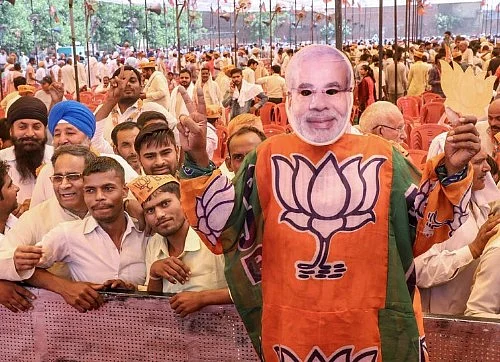
BJP’s logic and hope
The BJP’s penchant for smaller states dates back to late 90s when under the troika Atal-Advani-Joshi, the saffron party made it an electoral issue.
Having tasted the power in Janata Party government in 80s and again in 1996, desperately trying to capture the power at the Centre, BJP propagated theory of “developed-smaller states with much autonomy”, akin to the European states, as an alternative to the Indian federalism. Although, the idea did not yield any political dividends immediately yet it caught the imagination of the masses who had long been demanding for the creation of separate states in different part of the country.
When BJP patriarch, Atal Bihari Vajpayee, formed NDA government in 1998, he approved the creation of three smaller states including Uttarakhand, Chhattisgarh and Jharkhand from Uttar Pradesh, Madhya Pradesh and Bihar respectively. However, formalities could only be fulfilled when he came to the power again in 1999.
The decision to create three smaller states proved a watershed moment for BJP’s political fortune as after the division. BJP emerged the most powerful party in all three states and subsequently formed the governments. In two of the three states, it has been in the power for over a decade now. Taking a cue from the past experiment, the party strategists, according to the Minister, are planning to divide UP into four smaller states to achieve two objectives: One, it will successfully weaken the might of the mahagathbandhan. Secondly, the focus of the opposition parties as well as of the voters will again get diverted from the real issues.
As per the BJP source, party high command which invariably means Narendra Modi and Amit Shah, also shares the same view. It believes that the proposed step will damage the Congress party the most besides the smaller parties like RLD, Apna Dal and Peace Party would become political extinct or feel compelled to forge the alliance with the party on it’s condition.
After the division, he said, “the BJP feels that regional parties like BSP and the SP will face the same consequences what Rashtriya Janata Dal (RJD) faced in Bihar.”
Pertinently, after the division of Bihar, RJD lost its base in Jharkhand and Jharkhand Mukti Morcha lost its base in Bihar whereas the BJP which was a non-entity in the state gained prominence in both the regions.
Similarly, TDP and TRS met the same fate in Andhra Pradesh. After the division of the Andhra Pradesh, while Telgu Desham Party (TDP) ended up becoming up an Andhra based party, Telangana Rashtriya Samiti (TRS) shrunk within Telangana boundary. And the BJP emerged as a new challenge to the regional powers in both the states.
Will the SP suffer the most?
As per BJP’s assessment, SP which is the main constituent of the mahagathbandhan and the biggest hurdle in the way of the BJP’s progress in UP, will suffer the most following the proposed division of the state.
Founded in 1992 by Mulayam Singh Yadav, SP has ruled UP for four times –first in 1989, then in 1993, 2003 and in 2012—owing to the support from a rock-solid MY (Muslim-Yadav) support base. Yadav which constitutes 12 % of the total population and Muslim which makes 20 % of the total population had voted for SP after the demolition of the Babri Masjid.
Saffron party-strategists strongly believe that division of the geography will divide the polity of the UP also as Yadavs from Purvanchal (Eastern UP) will not vote for a Yadav from Harit Pradesh (Western Uttar Pradesh). Iron fisted clutch of Mulayam family over Yadav vote bank will receive a huge dent after the division, feels BJP.
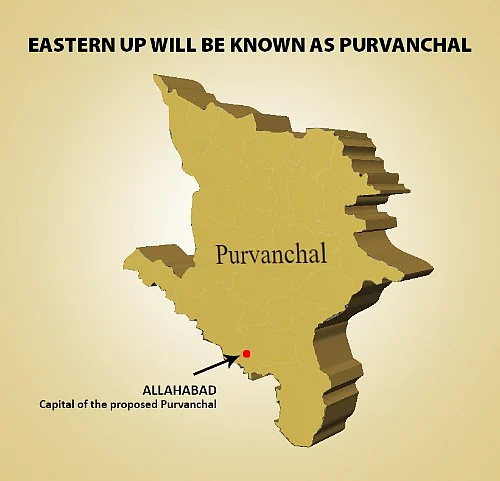
To demolish SP’s caste base, BJP had been working on a two-pronged strategy: One, party groomed, promoted leaders from non-Yadav OBC castes and aligned with smaller parties representing anti Yadav aspirations on the ground. Secondly, it created its own Yadav leaders who are ready to take on Mulayam family in electoral battle.
A senior SP leader who is in the know of the BJP’s plan, however debunked the plan, saying that “even after the division, if SP-BSP and Congress forge an alliance, BJP will be trounced in the forthcoming polls.”
Disastrous for Mayawati’s Dalit vote base?
Division of Uttar Pradesh into four smaller states will also divide the so far united Dalit vote bank, think BJP’s strategists. The saffron party has an eye on Dalit vote bank, which constitute 20-22 % of the total vote share in the state, since long. First, by Hinduisation of Dalits under the RSS watch, BJP has created a non-secular, Dalit vote bank over the years; and then by creating non-Jatav vs Jatav divide within Dalit community and by promoting urban faces from the community such as Uditraj, the BJP has already made inroads into the BSP’s electoral territory.
After the proposed division of the state, BJP high command believes that the BSP will shrink considerably, and may end up as a sub-regional outfit with an insignificant caste based support base restricted to Bundelkhand and Purvanchal.
“RSS believes that by creating non-Jatav Vs Jatavs divide, BJP has successfully snatched a considerable part of Mayawati’s political ground (according to an estimate 45 % of non-Jatav Dalits voted for the BJP Lok Sabha election – 2014). As data shows, support from non-Jatav Dalits played a key role in the success of the BJP in 2014, BJP leaders now want to cement it forever by breaking the state,” stated an RSS activist wishing anonymity.
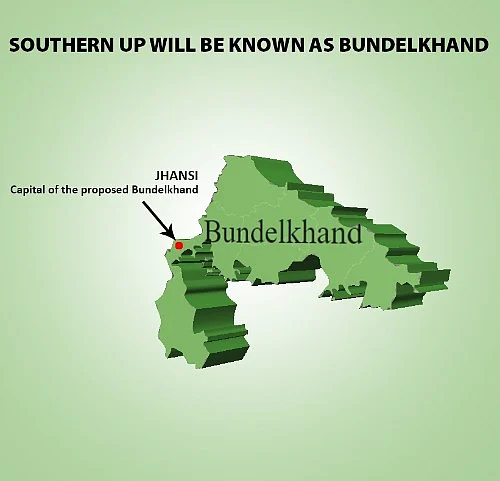
Congress will be confined to Amethi?
Rise of Rahul Gandhi—as a national leader and more importantly as an alternative to Modi and antidote to the poisonous politics of the BJP—has also made the saffron family jittery. By carving out four smaller states, BJP feels it can contain Rahul’s growing influence in UP as well. Congress seems to have not made up its mind on the issue. When asked, a senior Congress leader said, “We will wait and watch as to what they announce. Why should we start worrying now?”
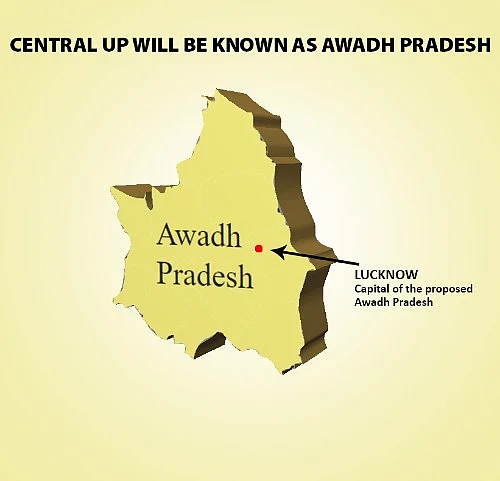
Some Congress leaders hold a different opinion: “Congress is a national party and is likely to gain from the proposed division. Victory in Gorakhpur and Phulpur by-polls has already set the motion in favour of the grand old party.”
Will RLD be made extinct in the Jat land?
Known as the Jat Party, Rashtriya Lok Dal (RLD) is one of the prominent parties in the Western UP. The party once enjoyed overwhelming support from the Jat community which constitutes nearly 27-30 % cent of the total regional vote share. But, in 2014-Lok Sabha election, riding on the communal wave BJP remained successful in taking away a major chunk of Jat votes from the party.
Although in recent Kairana by-poll, BJP suffered a humiliating defeat, yet the saffron party ideologues believe after the division of the Uttar Pradesh, RLD will not be able to withstand the renewed power of the BJP and thus would be decimated to a non-existent political entity in the region. In such a scenario, the Jat vote bank will come to the saffron party in the absence of many political alternative.
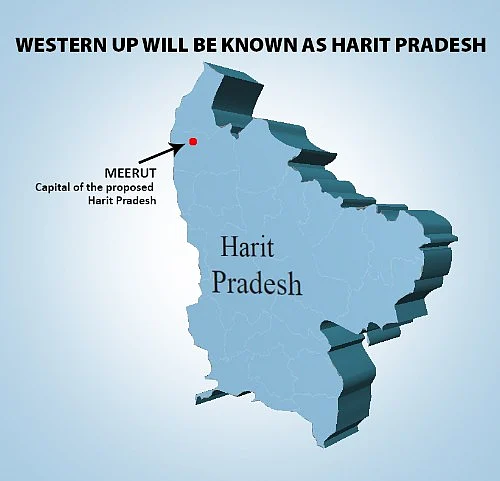
“We cannot match their might on the ground. Their money, muscle and mobilisation capacity are just unmatchable. Plus, they are the national party. They can sell big dreams to the voters. Besides, they have very successfully divided our base—farmers’ constituency into Hindu and Muslims. Of course, they will be in an advantageous position,” said a RLD leader, adding that in the face of grand alliance, BJP will not be successful to repeat 2014 success.
What does the Constitution say?
Article 3 of the Constitution—which deals with the “formation of new states and alteration of areas, boundaries or names of existing states”—empowers Parliament to create a new state out of existing ones. But, the role of the Parliament is secondary in the process. Union Cabinet first sends a proposal to the President who forwards it to the concerned assembly. After having been approved from the assembly and the President, the bill is placed for discussion in the Lok Sabha, Rajya Sabha, and can be passed with simple majority.
Usually, bills are first placed before the parliament for discussion and then sent to the President for his approval but in this case, it is the other way around.
Ambedkar’s book
Division of Uttar Pradesh into smaller states is an old idea, almost as old as our independence. Depending on the prospective political gains, the parties have toyed with the idea from time to time. Many believe that BSP supremo Mayawati was the first to propose to divide UP into four smaller states for better governance but the idea dates back to 1955 when BR Ambedkar through his book, “Thoughts on Linguistic States” proposed the idea of splitting UP into three states.
Then, two decades later, in 70s, former Prime Minister and iconic Jat leader Chaudhary Charan Singh again brought up the idea, demanding that a “Harit Pradesh” be carved out from the rest of the UP.
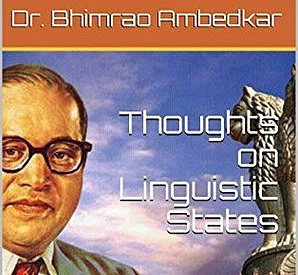
With the rise of the SP in late 80s and 90s, the demand, however, pushed on the back burner. Again in 2012, the then Chief Minister Mayawati sent the proposal to the Centre but to no avail.
Curiously, according to sources, many seniors in the BJP fear that the idea may backfire. To put it precisely, in words of a BJP watcher: “Rafale scam, GST-demonetisation disaster and Dalit-Mulsim uprising has forced BJP to delay breaking UP as of now or indulge into any such misadventure in near future. But it won’t hesitate to play the gamble if the situation demands so ahead of 2019 elections.”
Follow us on: Facebook, Twitter, Google News, Instagram
Join our official telegram channel (@nationalherald) and stay updated with the latest headlines